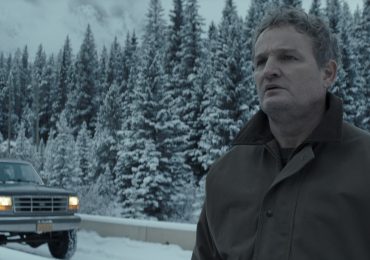Though the Netflix sports drama Rez Ball, premiering at the Toronto International Film Festival, is technically “inspired by” articles and a book written by journalist Michael Powell, co-writer Sterlin Harjo explains he didn’t read all that material.
“I didn’t need to read the book,” he says. Instead, director and co-writer Sydney Freeland was his “source material.” Harjo and Freeland are both indigenous; Powell is not. And while Harjo, best known as the co-creator of Reservation Dogs, grew up in Oklahoma mostly playing football, Freeland has experience hooping on a Navajo reservation, just like the students in their story.
[time-brightcove not-tgx=”true”]
“It was from her community and she played basketball there,” he says. “It was really about just telling a real story that we both connected to and felt authentic and real to us.”
Rez Ball takes the general contours of its narrative from the real-life culture that surrounds Native American high school basketball, which Powell documents in the 2019 book Canyon Dreams: A Basketball Season on the Navajo Nation, but its story is a fictional one created by Freeland and Harjo. With intimate knowledge of the world they wanted to portray, Freeland and Harjo started inventing their story.
“For us it was really trying to build this world from the ground up,” Freeland says.
What is Rez Ball about?
The term “rez ball” is used to refer to basketball played on Native American reservations, where Freeland says the game is as integral to the community as football is to West Texas. (Think: Friday Night Lights.) As Freeland says, it has a “rabid following.”
“We don’t have professional sports teams back home, we don’t even have college teams,” she adds. “What you have is high school sports, and a lot of that fell onto basketball because that’s what a lot of indigenous communities excelled at.”
Freeland remembers the intensity of the competition from when she was playing, including at times getting police escorts to and from games because of the heightened nature of the rivalries between tribes.
While Canyon Dreams focuses on the Chinle High School Wildcats in Chinle, Ariz., Rez Ball turns its lens on the Chuska Warriors in Chuska, N. Mex. The star player is Nataanii Jackson (Kusem Goodwind) who is grieving the deaths of his mother and sister, who perished in a drunk driving accident. His best friend Jimmy Holiday (Kauchani Bratt) is suddenly thrust into the spotlight when Nataannii tragically dies by suicide.
The film hits the traditional beats of a sports movie: The Warriors have to move past their sorrow and win for themselves and their community. Along the way they embrace the specificities unique to their upbringings, including starting to call plays in the Navajo language. “We definitely have parallel experiences of sh-t talking in Native languages,” Freeland says. “Teams sh-t-talking each other and not knowing what each other was saying, but we tried to bring it together in that very specific targeted way of them actually taking the Navajo language.”
Freeland and Harjo were thinking about the language of films like Hoosiers when writing their screenplay. Sports, Harjo says, have life and death stakes. “There is pressure from sports and you put pressure on something that is already broken or cracked and you can guarantee it’s going to break,” Harjo says.
Read more: Why Sports Movies Are Making a Glorious Comeback
A female coach
While you’re used to seeing a guy come around and whip a team into shape, the coach of the Warriors is Heather Hobbs (Jessica Matten), who has returned home after a stint playing professional basketball. Freeland explains they didn’t want a Gene Hackman-type—another Hoosiers reference—coming in as a “white savior.” (Powell’s book is largely focused on coach Raul Mendoza, described as a “four-decade long coaching force on the Navajo reservation, married to a Navajo woman yet not Navajo himself, respected although perhaps not beloved.”)
As a character, Heather was not just a way to buck pre-established tropes, but also a way to honor a thriving tradition of women’s rez ball. “The girls teams on reservations have actually had traditionally a lot more success than the boys’ teams,” Freeland says. Heather’s last name is a tribute to Gwen Hobbs, a Native player who was inducted into the University of Nevada, Las Vegas hall of fame. In one scene, the Chuska girls team is shown beating up on the boys.
Having a female leader in a Native American community also just made sense, Harjo says. “Both Sydney and I come from matriarchal communities,” he says. “You get disciplined by the women and you have strong women to look up to whether you’re a woman or a young man or whatever.”
Read more: 13 Remarkable Sports Documentaries to Stream Right Now
Players who can ball
To add to the authenticity of the project, Freeland had a key demand: She wanted Native actors who could actually play basketball. With casting director Angelique Midthunder she put out a casting call that required her potential stars to not just read a scene, but also demonstrate that they could shoot a free throw, a three-pointer, and a layup. They initially got 5,000 submissions.
“One of the things I’m really proud about is not only these kids are from the communities that they are portraying—these are urban Indians, these are rez kids, these are everything in between—but there are no doubles in this movie, these kids are all playing ball,” Freeland says.
During filming the cast not only took acting lessons, but they also did Navajo classes and basketball practice. “They had never set foot on a film set before,” Freeland adds. For the Toronto premiere, some of them didn’t have passports so those had to be arranged.
“These kids are the real deal,” she says. “They’re actually playing basketball. They’re acting their asses off.”
Leave a comment








